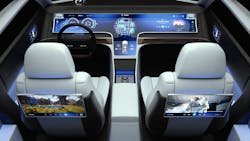This article appears in the CES Show Report in the February 2022 issue of Security Business magazine. When sharing, don’t forget to mention Security Business magazine on LinkedIn and @SecBusinessMag on Twitter.
When you think of consumer electronics, the latest and greatest in televisions, speakers, virtual reality, drones and computers are the first things that come to mind. After one day of the 2022 version of CES, it is abundantly clear that automobiles are (pun intended) the driving force behind a huge chunk of the innovations on display in Las Vegas both in-person and virtually.
It doesn’t matter what kind of company it is, if they aren’t showcasing some innovative aspect of autonomous vehicles and computer-assisted driving systems, they are not generating as much buzz in 2022; in fact, just about every major company – from Qualcomm and Microsoft to small startups you have never heard of – made big announcements related to the auto industry at CES.
Those of us who follow CES for potential security industry innovation may have been a bit disappointed by this turn of events, but this is a case where it helps to see the forest instead of the trees.
The good news is that like most hot tech trends in the long history of CES, the R&D and innovations pouring into one industry are bound to leak into another, and the vast resources being put into technologies to power autonomous vehicles and Advanced driver-assistance systems (ADAS) will uncover innovation in the security industry.
Here are some show floor examples that made big news on day one of CES:
LiDAR
LiDAR technology has long been foundational to autonomous vehicles, but as our tech expert correspondent Steve Surfaro has written about on multiple occasions, it is building a place among perimeter security options.
“The biggest barrier is that prices need to come down to allow our industry to really drive mass adoption and democratize LiDAR so that more people can use it in more applications,” said Dr. Ted Tewksbury, CEO of LiDAR provider Velodyne, during a virtual CES press conference. “The prices will come down as they always do when new technologies start to get the volume. One of our pillars is to develop new architectures that will bring down prices so that we can drive broader adoption of LIDAR across a wider range of applications.”
Semiconductor Chips
Autonomous vehicles are hungry for the processing power these chips provide. A company like NXP Semiconductors may not be focused on video surveillance, but its flagship S32R45 and new S32R41 processors are enabling 4D imaging radar for 360-degree surround sensing in cars. It isn’t hard to imagine these innovations coming to an intelligent security camera in the near future.
Displays
One of the goals of ADAS is to create a more user-friendly and safer driving experience by making display technologies easier to disseminate in real time.
Qualcomm – a company more known for its smartphone technologies – made big news at CES with its newest Snapdragon Cockpit Platform, which “features enhanced graphics, multimedia, computer vision and artificial intelligence capabilities to provide a more integrated, contextually aware and constantly adaptive cockpit system that evolves to its passengers’ preferences. The 4th Generation Snapdragon Cockpit Platforms are engineered as a homogenous and multipurpose solution to address the transition to zonal architectures, serving as a central hub for high-performance compute, computer vision, artificial intelligence (AI) and multi-sensor processing with a flexible software configuration to address the compute, performance and functional safety needs for that zone or domain.”
These chips will be featured in new vehicles from Volvo and Honda in the future, but once fully adopted by the automotive industry, imagine what these chips could do for an operator in a modernized Security Operations Center or monitoring center.
Camera Glass
In order to perform optimally, exterior automotive cameras and systems need nearly perfect vision that cannot be obscured. In searching the CES exhibitors, I found a company that has created a waterdrop resistant glass to be used in the lenses of these cameras. This technology is already being used for outdoor security cameras as well (more on that in the days to come from Surfaro, who is on site).
Cybersecurity
Cybersecurity is a big deal when it comes to autonomous vehicles. As cars get more connected, the risk of cybersecurity breaches increases – and just like CISOs dealing with evolving ransomware threats, it is a constant battle to keep up with changing methods and attack vectors.
The International Organization for Standardization (ISO), in fact, created in August ISO/SAE 21434, a standard that addresses the cybersecurity perspective in engineering of electrical and electronic (E/E) systems within road vehicles.
C2A Security, a provider of trusted automotive cybersecurity solutions, earned a CES 2022 Innovation Award for its flagship product, AutoSec, a comprehensive cybersecurity lifecycle management system (CSMS) that empowers industry stakeholders to identify and mitigate cyber-attacks in this challenging environment.
According to a press release, the product “allows organizations to manage all of their cybersecurity needs in one centralized location, including Threat Modeling (TARA), vulnerability management, and in-vehicle protection, along with collaboration, delegation of threat identification, and prevention across the supply chain. Its embedded orchestration layer significantly shortens response time to security events.”
Certainly not a stretch to see how a product like this can be used in our industry.
Paul Rothman is Editor-in-Chief of Security Business magazine. For more coverage from CES 2022, visit www.securityinfowatch.com/ces frequently this week.
About the Author
Paul Rothman
Editor-in-Chief/Security Business
Paul Rothman is Editor-in-Chief of Security Business magazine. Email him your comments and questions at [email protected]. Access the current issue, full archives and apply for a free subscription at www.securitybusinessmag.com.

